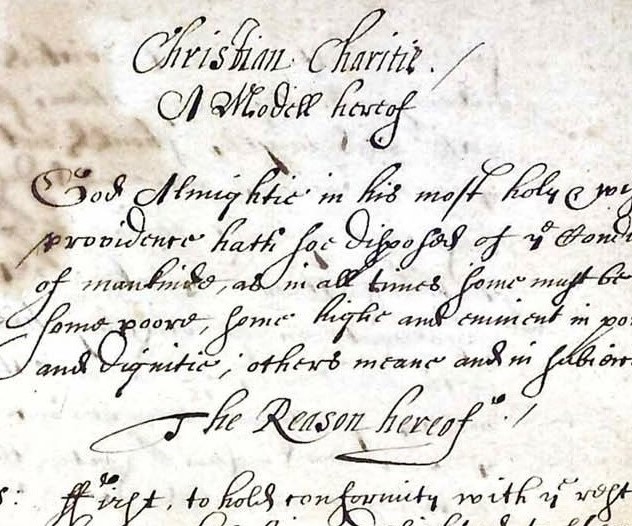A City on a Hill: Why John Winthrop and the Puritans Came to America
The Puritans, led by John Winthrop, came to America in 1630 in search of prosperity and, like the Pilgrims, for religious and political freedom. Their religious faith and views were very influential in their goals for coming to America and in the forming their new colonies.
Winthrop laid out many of the Puritans’ reasons for migration in his 1629 “Reasons to be considered for justifying the undertakers of the intended plantation in New England.” The Puritans, he explains, hoped to escape economic hardship and what they saw as worldly evils—corruption of churches and schools—in England and Europe. They also hoped to escape what they saw as remaining heresies and religious regulations in the Church of England. They saw America as a place where they could live out their beliefs, purify and fully reform the church, and advance the Christian Gospel.
In his well-known 1630 Model of Christian Charity sermon, Winthrop further explains the Puritans’ civil motives for migration. They desired to create a new Bible-centered commonwealth or civil state held together by Christian brotherly love, peace, and unity. Their community would be based on covenants and godly, moral laws. Referencing Matthew 5:14, they ultimately hoped that their community would provide a godly model—a “city on a hill”—for Europe and the world. “For we shall be a city on a hill,” writes Winthrop. “The eyes of all people are upon us.” In Matthew 5:14, Jesus tells His followers, “You are the light of the world. A city that is set on a hill cannot be hidden.”
Indeed, the Puritans had a great vision in coming to America. They hoped to create a civil society where they could worship as they chose, spread the Gospel, and enjoy just, equitable, moral civil laws. Their religious faith and convictions largely shaped their motives and goals for coming to America and the ways in which they sought to build their new, uncharted colonies. In many ways, they looked to the Bible for direction and guidance as they entered this uncharted territory and experiment, in forming what they hoped would become a shining “city on a hill,” a model for all the world.
Contributed by AHEF and Angela E. Kamrath.
Source for more information:
Kamrath, Angela E. The Miracle of America: The Influence of the Bible on the Founding History and Principles of the United States of America for a People of Every Belief. Second Edition. Houston, TX: American Heritage Education Foundation, 2014, 2015.
Related articles/videos:
1. An Introduction to Popular Sovereignty
2. Who were the Pilgrims? Why did they come to America?
3. Why the Pilgrims Identified with the Ancient Israelites
4. The Mayflower Compact: The Pilgrims’ First Self-Governing Act in America
5. The Pilgrims’ Mayflower Compact as Covenant
6. The History of Thanksgiving Day in America
7. The Pilgrims & Private Property: What the Pilgrims Might Have Thought About Communism & Socialism
8. Three P’s That Led to Freedom in the West: Printing Press, Protestant Reformation, & Pilgrims
9. The Puritans’ Moral Authority was the Bible
9. The Puritans in America Identified with the Ancient Israelites and Practiced Covenants
10. Why the Puritans Favored Limited Government
11. The Puritans in America Favored Rule of Law
12. Why the Puritans Elected Representatives to Govern in their American Colonies
13. Why Puritan Thomas Hooker Favored Democracy Over Aristocracy
14. Challenges in the Early Puritan Colonies: The Dilemma of Religious Laws & Religious Dissent
15. Why and How Did Schools Begin in the United States: The Puritans Supported Education for Bible Literacy
—–
Activity: Miracle of America High School Teacher Course Guide, Unit 3, Part 1 of 3, Activity 3: Learning More About the Puritans, pp. 104, 318-319. MS-HS. See prior blog post for access to this activity.
Activity: Miracle of America High School Teacher Course Guide, Unit 3, Part 1 of 3, Activity 4: Let’s Go to America! The Puritans’ Problems, Hopes, and Goals, pp. 104, 317. MS-HS.
Let’s Go to America! The Puritans’ Problems, Hopes, and Goals
Purpose/Objective: Students learn about the Puritans including their beliefs and practices such as covenants, identification with the Israelites, reasons for migrating to America such as religious freedom, leaders, and desire to form Bible Commonwealths in their colonies of Massachusetts and Connecticut.
Suggested Reading: Chapter 3 of Miracle of America sourcebook/text. Students read sections Introduction to 3.4.
Comparison Chart, Two-Column Notes, and Think-Pair-Share. Students read all or part of John Winthrop’s “Reasons to Be Considered” and selections from Winthrop’s Model of Christian Charity sermon on reasons and goals for migrating to America. Students may optionally read selected quotes from the Miracle of America text/sourcebook that the teacher has excerpted out. In Two-Column notes, students outline in writing the reasons why the Puritans left England and their goals and hopes in coming to the New World. The left column will be the “negatives” or problems in England. The right column will be the “positives” or hopes and goals of the Puritans in coming to America. Share and discuss in pairs or groups. Students also think about/discuss how the Puritans compare with the Pilgrims (Unit 2)—regarding their religious beliefs, reasons for migration, and identification with Israelites. Follow with discussion.
The Two-Column Note format and Think-Pair Share can be downloaded at www.americanhertitage.org
To download this whole unit, sign up as an AHEF member (no cost) to access the member resources page on americanheritage.org.
Copyright © American Heritage Education Foundation. All rights reserved.
